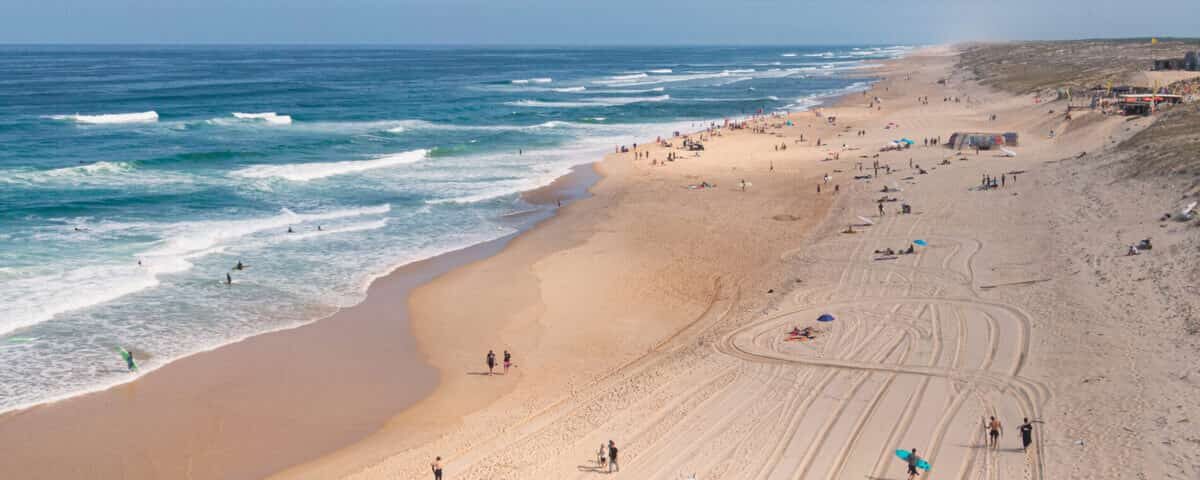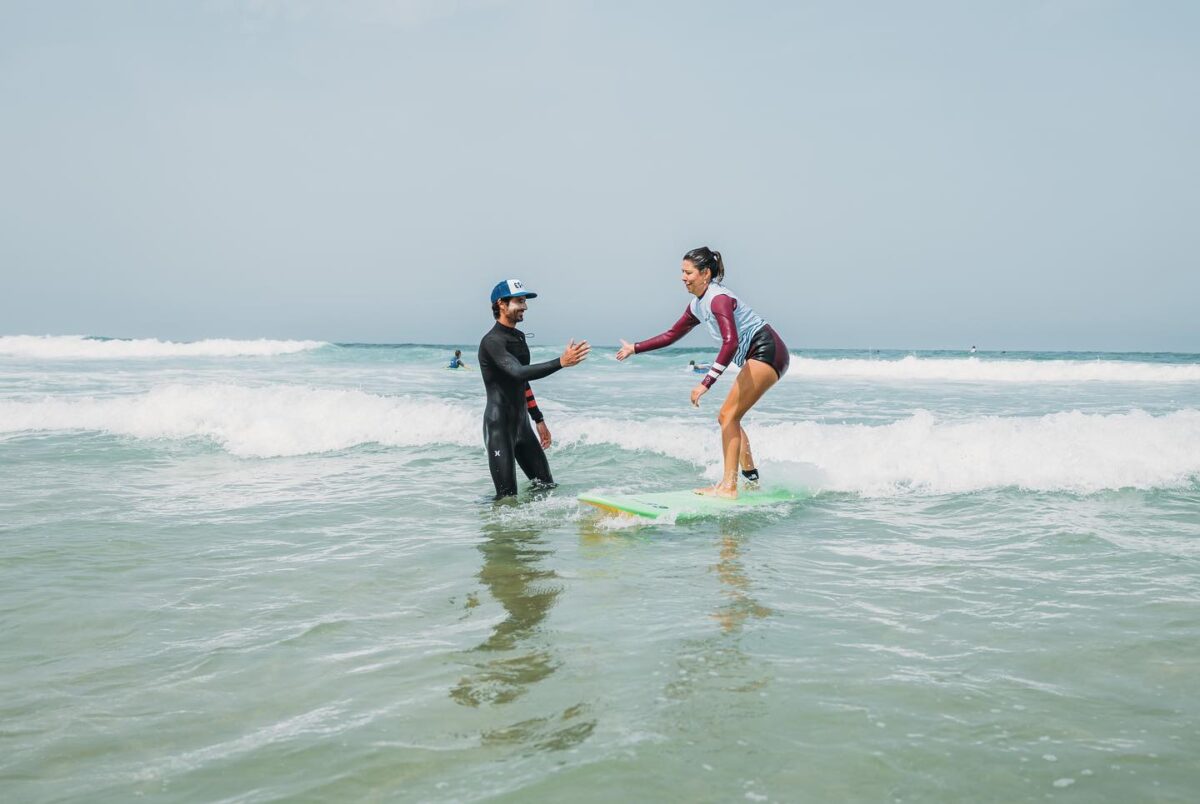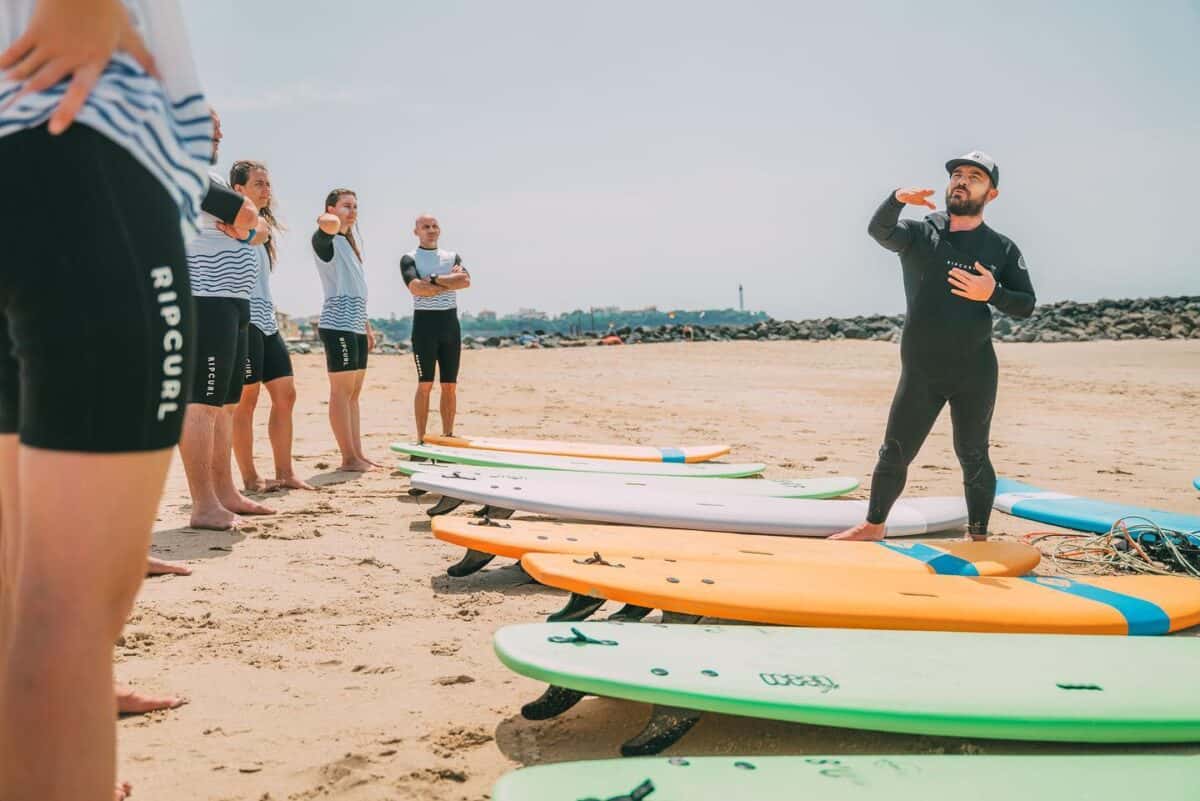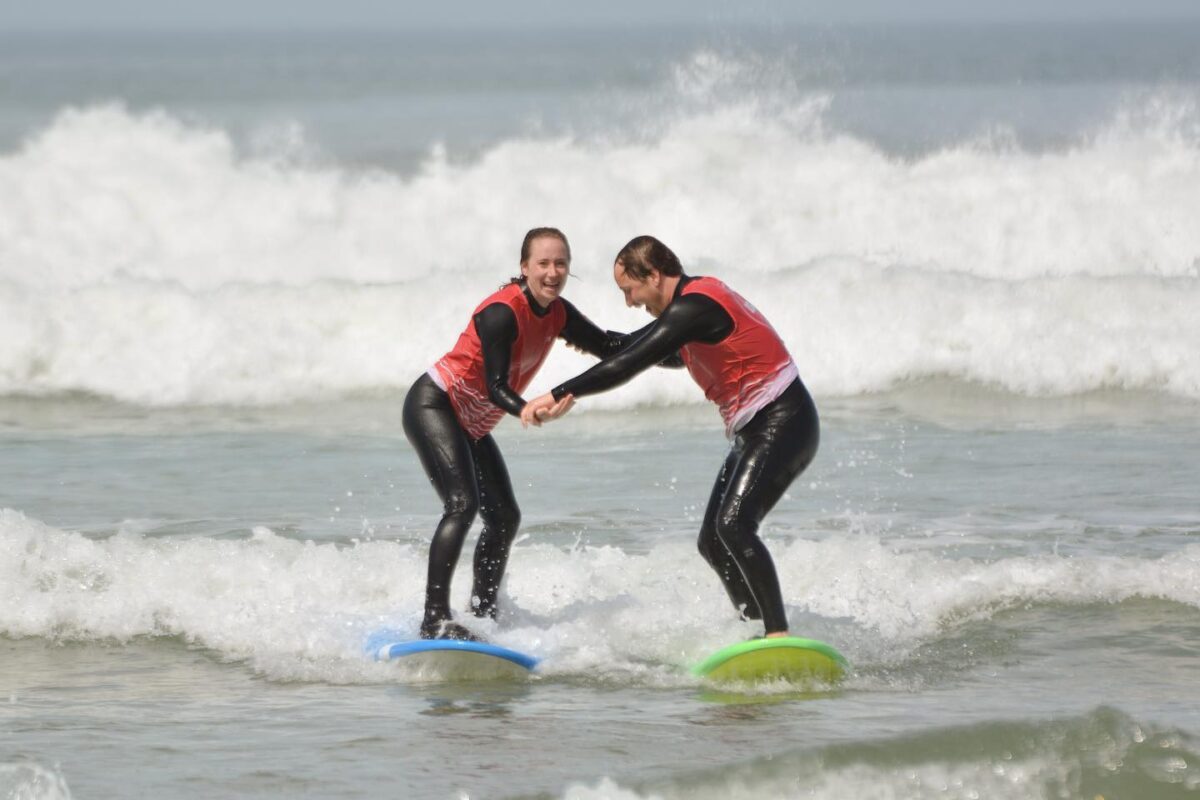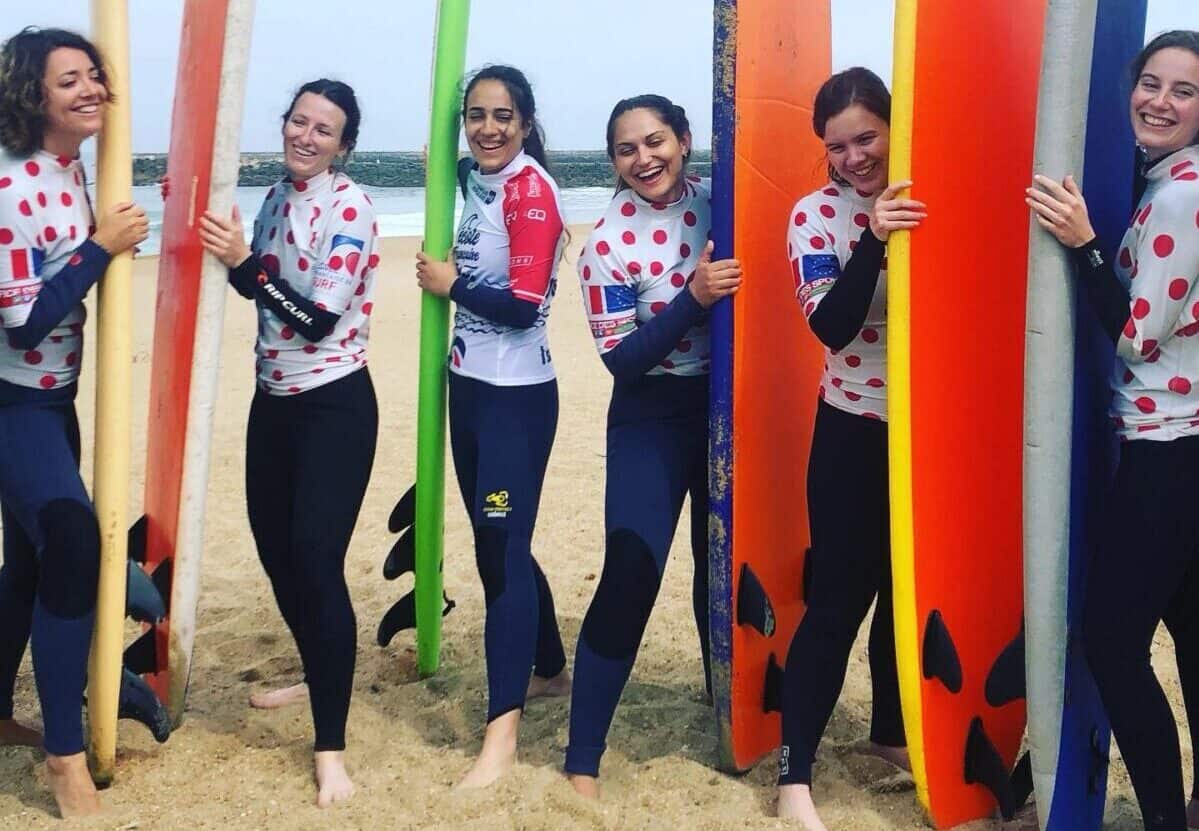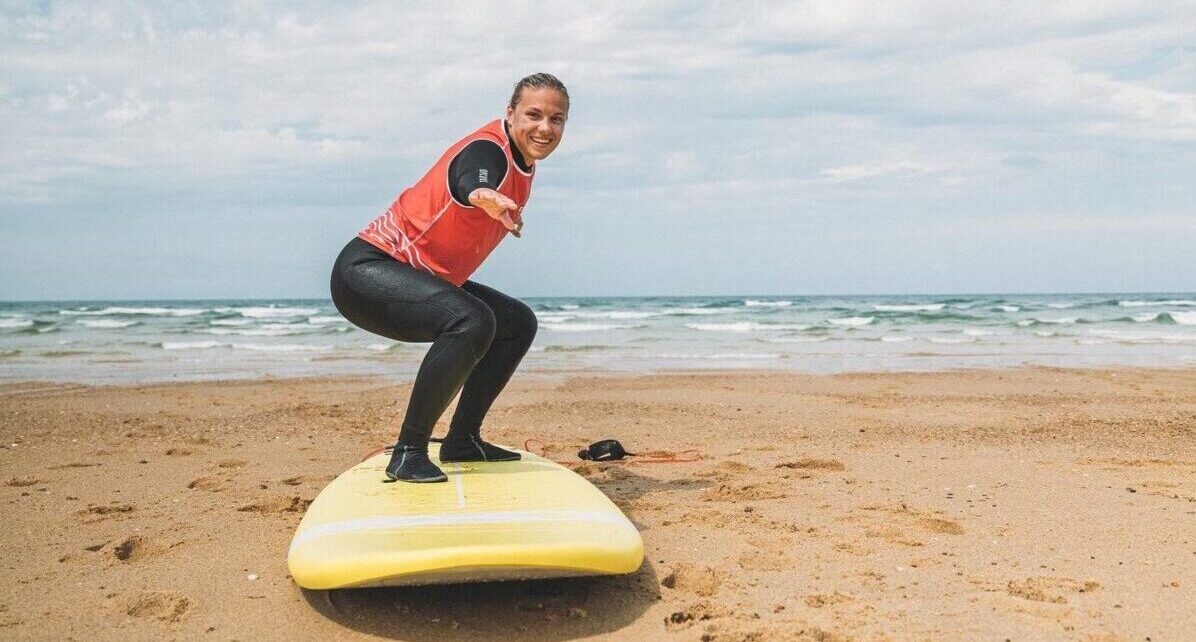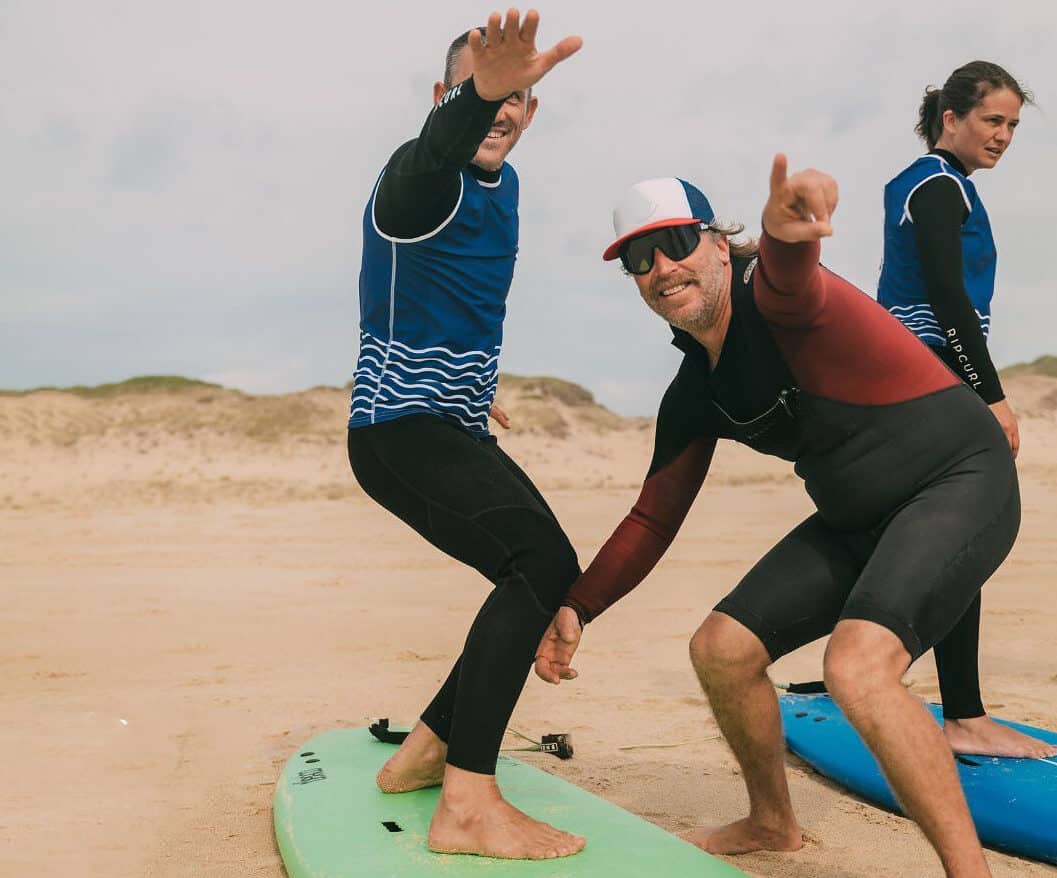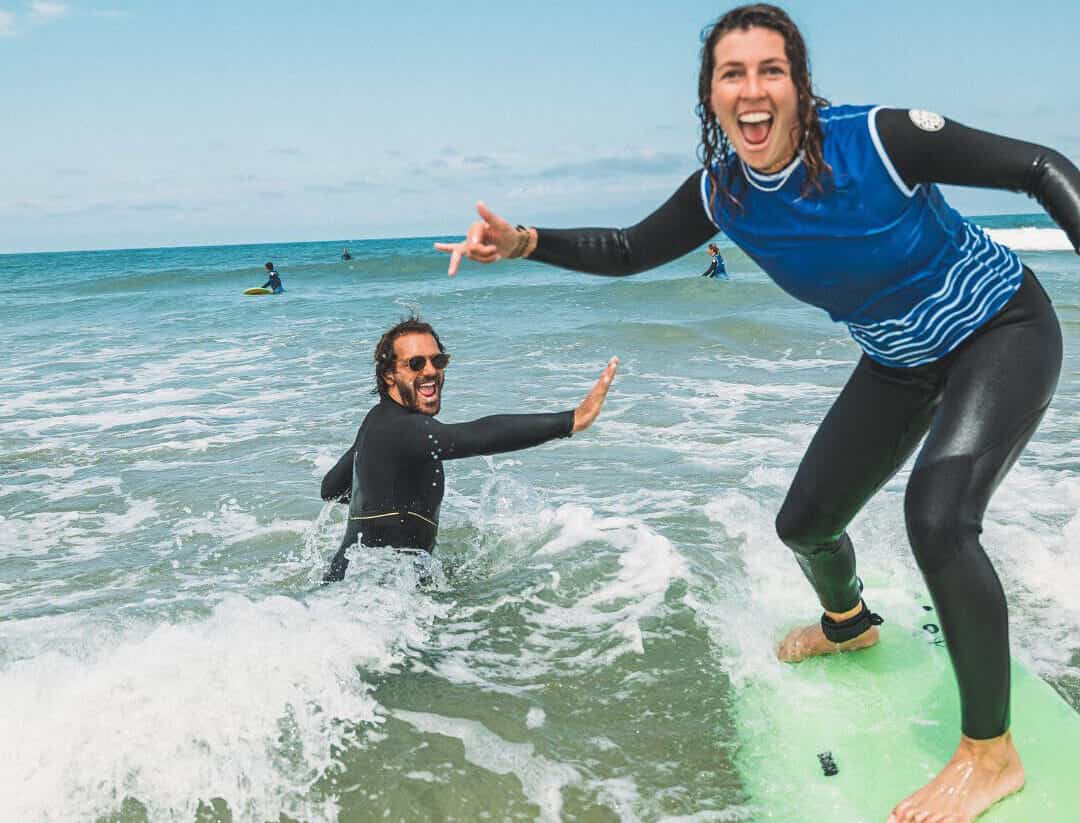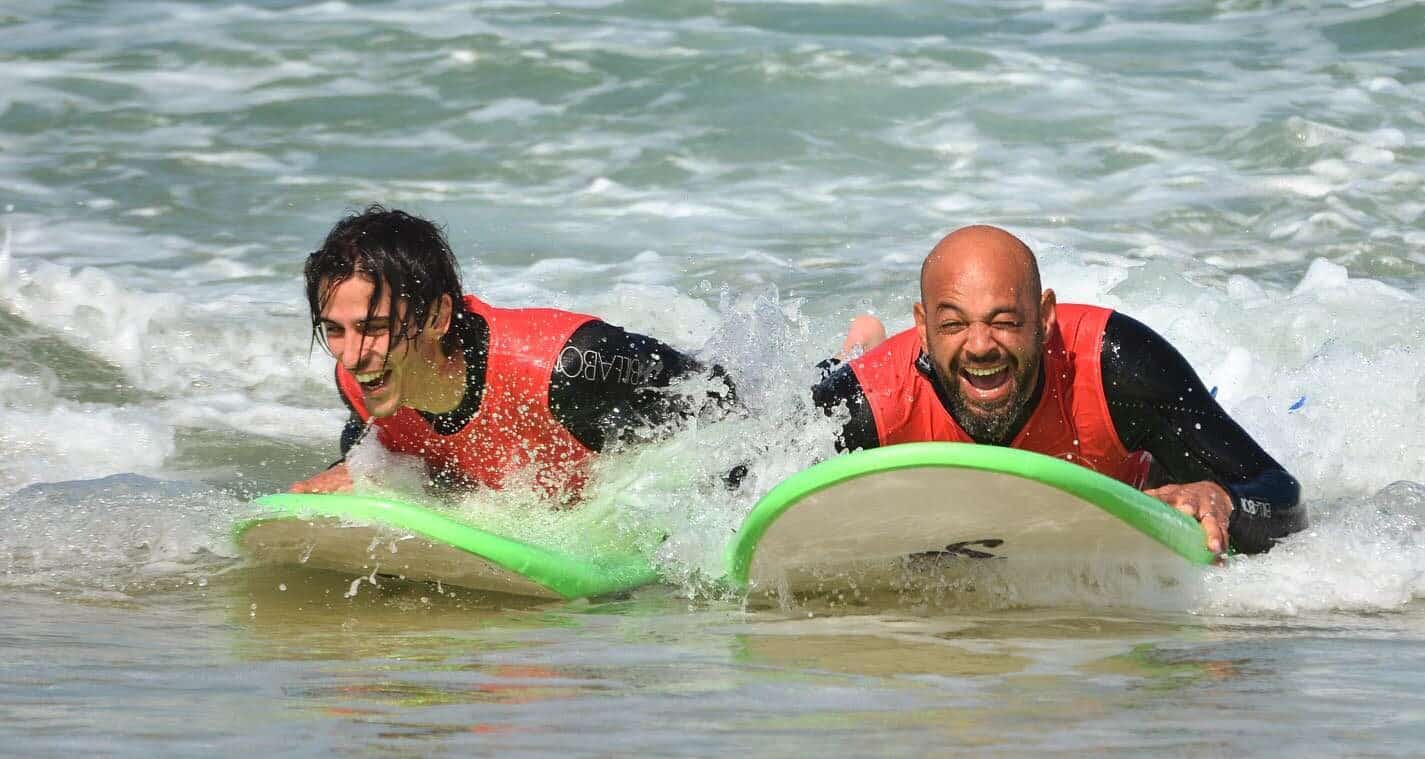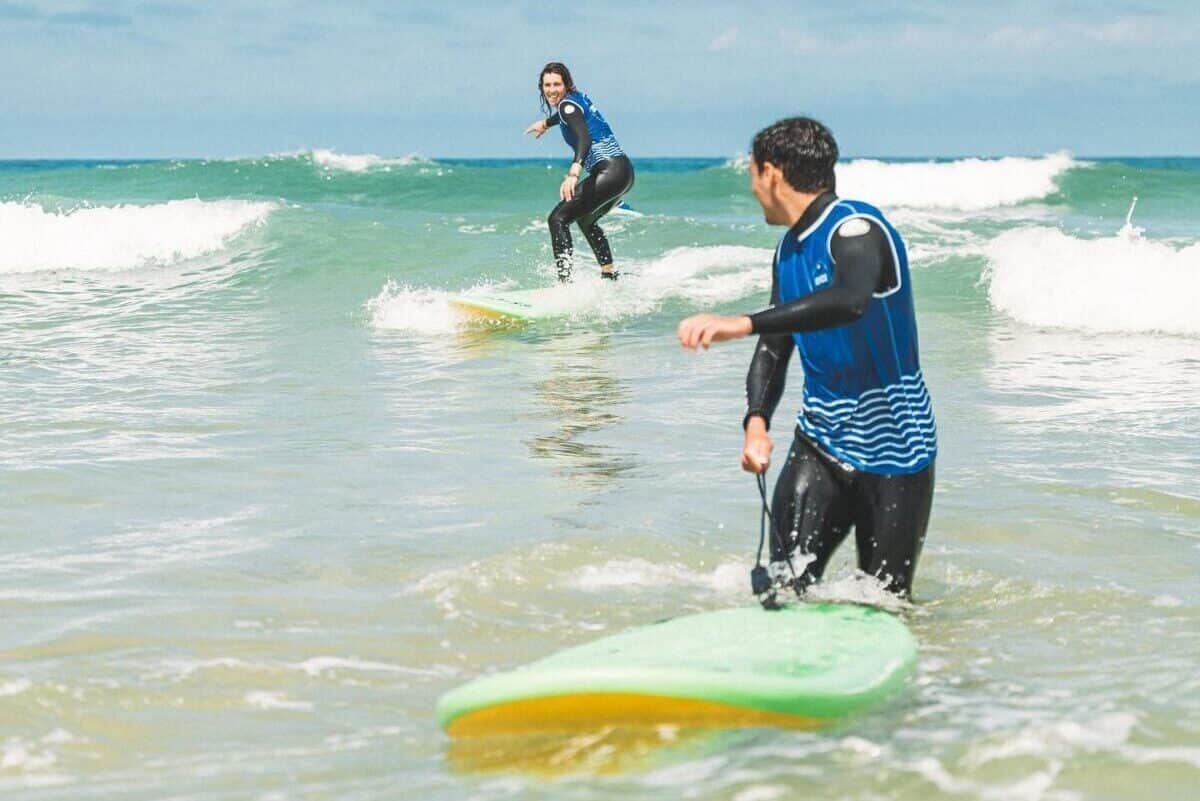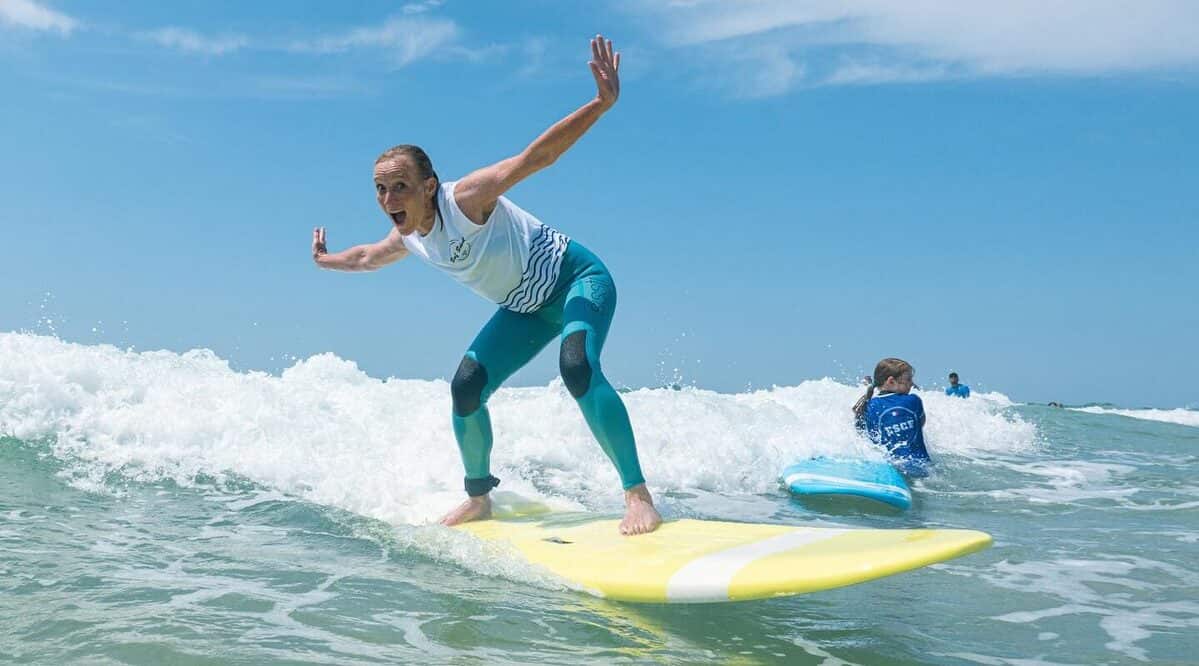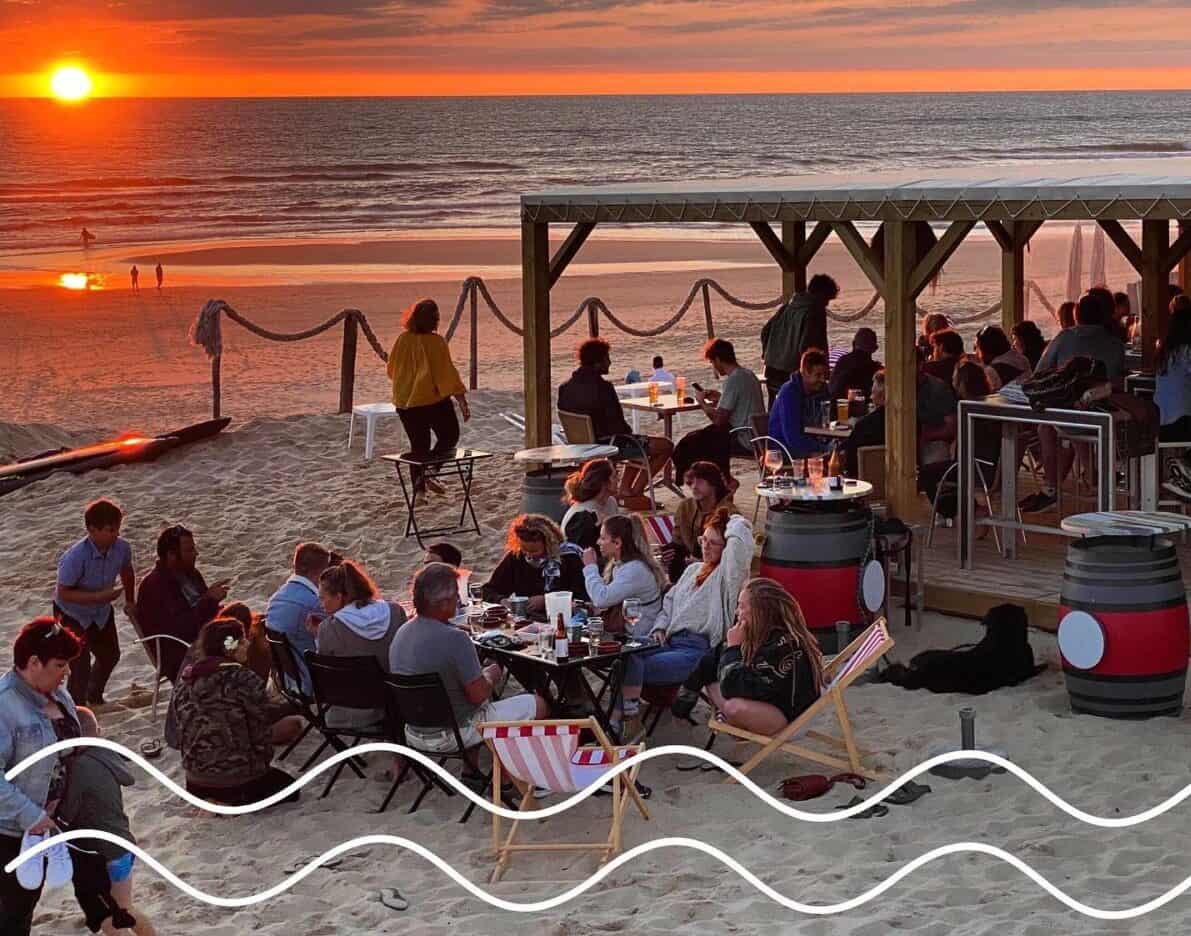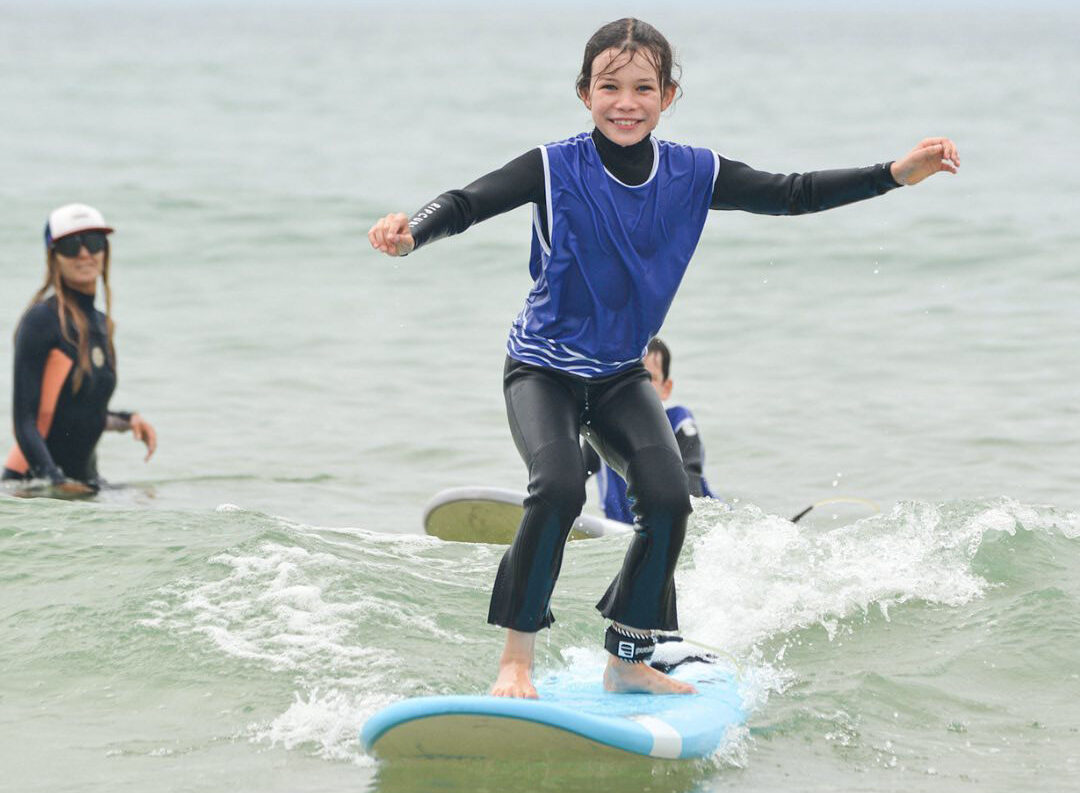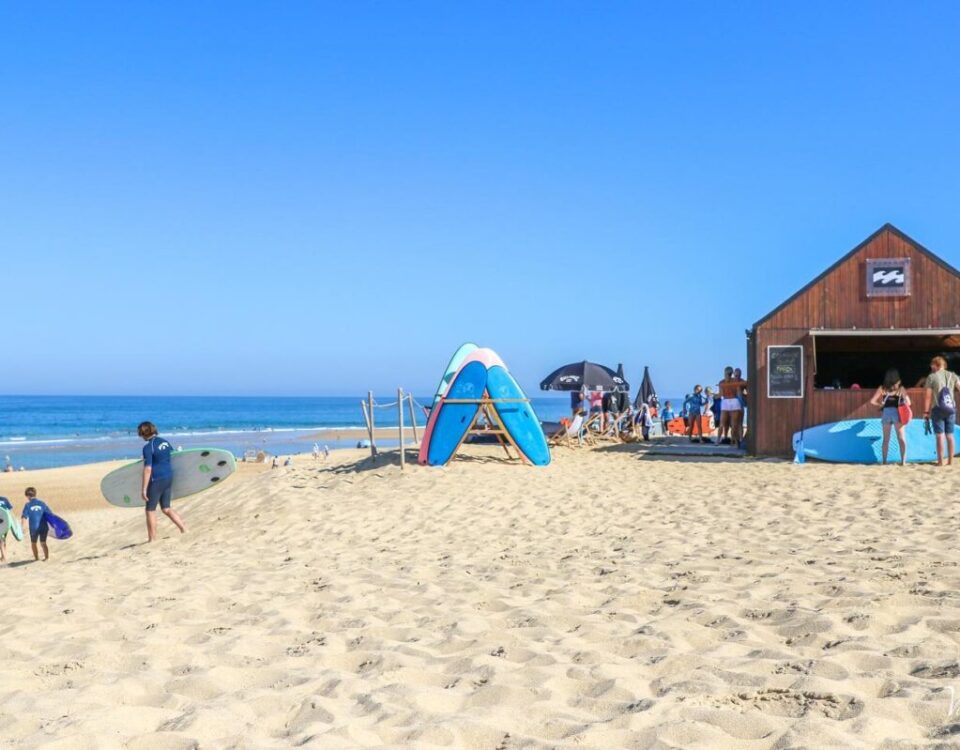
How do I get to Dakhla ?

Hossegor: The Surfing Capital of Europe
Surfing in Seignosse: Dream Waves for Beginners and Pros is a comprehensive guide to the captivating world of surfing in Seignosse, a dream destination for surfing enthusiasts. Whether you’re a beginner or an experienced surfer, this book gives you the knowledge and advice you need to explore the turquoise waters of Seignosse and experience unique sensations on the waves.
Throughout these pages, you’ll discover the very essence of Seignosse, a true surfing paradise on the south-west coast of France. You’ll learn the fundamentals of surfing, from paddling techniques to advanced manoeuvres and aerial tricks. You’ll explore the different types of waves offered by Seignosse and delve into the secrets of the region’s most popular spots.
This book goes beyond the technical aspect of surfing by also focusing on safety in the water, physical and mental preparation, and the creation of a community of enthusiasts. You will be guided step by step, chapter by chapter, to improve your balance, your position on the board and your ability to read waves accurately.
Whether you want to learn the basics of surfing, perfect your style or push your limits in more powerful waves, Le Surf à Seignosse is your ultimate companion. Get ready to immerse yourself in a world where the ocean becomes your playground and every wave offers you an opportunity to experience the incomparable adrenaline and freedom of surfing.
Contenus de la page
The Magic of Seignosse: A Surfing Paradise
Welcome to this guide to surfing in Seignosse, a magical place considered to be a true surfers’ paradise. Nestling on the south-west coast of France, this seaside destination offers dream waves, fine sandy beaches and an enchanting atmosphere that’s sure to win you over.
The Natural Beauty of Seignosse
As soon as you set foot in Seignosse, you’ll be immediately captivated by its natural beauty. The commune is bordered by a vast pine forest that blends harmoniously with the coastline. You’ll be surrounded by lush flora and diverse fauna, creating a preserved ecosystem and a breathtaking landscape. The sea air will wash over you, laden with sea spray and invigorating freshness.
The History of Surfing in Seignosse
Surfing in Seignosse has a long history dating back to the 1960s, when the first enthusiasts discovered the possibilities offered by the region’s waves. Since then, Seignosse has become a major surfing destination in France and Europe, attracting surfers from all over the world.
World-renowned surfing competitions are regularly held on the beaches of Seignosse, attracting professionals from all over the world and making the town a true surfing crossroads. Local surfers are proud of their heritage and their contribution to the surfing scene.
Exceptional Surfing Conditions
Seignosse benefits from a privileged geographical location that allows it to receive swells from the Atlantic. This creates exceptional surfing conditions all year round. Whether you’re a beginner or an experienced surfer, you’ll find what you’re looking for on Seignosse’s many beaches.
The waves here are renowned for their quality and variety. From beach breaks to reef breaks and legendary point breaks, you’ll be spoilt for choice. The waves are powerful and often hollow, offering spectacular tubes and manoeuvres. Whether you’re looking for the adrenalin of fast waves or the gentleness of more accessible waves, Seignosse has everything to offer.
A warm and welcoming atmosphere
The atmosphere in Seignosse is one of friendliness and authenticity, making this destination a real gem. The locals and surfers are renowned for their hospitality and passion for surfing. You’ll be welcomed with open arms in this community, where the atmosphere is relaxed and friendly.
The many surf spots dotted along the coast offer endless opportunities to meet other surf enthusiasts and share memorable sessions. Surfers often talk to each other, whether it’s to exchange tips, share wave stories or simply celebrate a great session together. Seignosse will give you a real sense of camaraderie and make you feel right at home.
Life outside the water
Although surfing is Seignosse’s flagship activity, there are plenty of other ways to have fun away from the water. You can enjoy the surrounding nature by walking through the forest trails, cycling along the picturesque cycle paths or taking part in water sports such as paddle or kite surfing.
Seignosse also offers a rich and varied gastronomy, with numerous restaurants and bars where you can sample local and international specialities. Indulge in Basque and Landaise cuisine, enjoy fresh seafood and discover the regional wines that are the perfect accompaniment to your meals.
In conclusion, Seignosse is much more than just a surfing destination. It’s a true paradise where the waves mingle with unspoilt nature, where the history of surfing is intertwined with a warm atmosphere, and where the ocean invites you to enjoy unforgettable experiences. Whether you’re a beginner or a seasoned surfer, Seignosse will meet all your expectations and offer you magical moments on the waves. Get ready to dive into this unique adventure where surfing becomes a real passion.
Surfing Fundamentals: Basics for Beginners
In this section, we’ll explore the fundamentals of surfing, the essential basics that every beginner needs to know before embarking on this exciting adventure. Whether you’re an absolute novice or have already had some experience on a surfboard, this chapter will give you the basic knowledge and skills you need to catch your first waves in Seignosse.
Surfboards: Types and Choices
The first thing to consider when you start surfing is your choice of board. There are different types of board for different levels of ability and wave conditions. Longboards offer greater stability and paddling ease, making them ideal for beginners. Shortboards, on the other hand, are more responsive and suitable for more experienced surfers.
When choosing your board, take into account your skill level, height and weight. It’s also a good idea to seek professional advice in a surf shop to find the board that’s right for you.
The Basic Position: Row and Pop-up
The basic position is crucial to getting a surf session off to a good start. Lying on your board with your arms out in front of you, use your hands to paddle through the water. Keep your head up so you can watch the approaching waves. When you feel you’re about to catch a wave, perform a ‘pop-up’ using your arms to push your body upwards and stand up quickly on your feet.
Practise the basic position and the pop-up on the beach before getting into the water. This will allow you to develop coordination and fluidity in your movements, preparing you for the waves.
Balance and positioning on the board
Once you’re up on your board, balance is key to staying stable and in control. Keep your feet shoulder-width apart, your knees slightly bent and your gaze directed towards the horizon. Distribute your weight evenly between the front and back of the board to maintain stability.
Positioning on the board will depend on the position of the wave. When you paddle out to catch a wave, position yourself in the take-off zone so that you can glide down the slope of the wave.
Wave catching and take-off
Catching a wave is one of the key moments in surfing. When you spot a wave approaching, paddle energetically to place yourself in the ideal position to catch the wave. Once you feel the wave carrying you, perform a take-off by pushing your body upwards and standing up quickly on your feet. Keep your gaze directed towards the front of the board and bend your knees slightly to maintain your balance.
When you take off, it’s important to keep your posture relaxed and stay centred on the board. Avoid looking at your feet and concentrate on the direction you want to go. Keep your arms slightly apart to maintain your lateral balance.
Management and control of the board
Once you’re up on the board and catching the wave, it’s time to work on steering and controlling your trajectory. By tilting your weight to one side or the other, you can steer the board in the direction you want to go. If you want to go left, tilt your weight to the left, and vice versa to go right.
Use your arms as balance beams to help you maintain your balance and adjust your trajectory. Learn to read the wave and anticipate deeper or less powerful sections so you can adjust your position on the board accordingly.
Safety and Surfing Ethics
Surfing is a sport that is practised in harmony with the ocean and other surfers. It is important to respect certain safety and ethical rules to ensure the safety of all surfers in the water.
Learn the signs and codes of surfing to communicate with other surfers in the water. Respect wave priorities and be aware of your surroundings. Avoid surfing too close to other surfers to avoid collisions.
Don’t forget to take into account the weather conditions and currents before getting into the water. If you’re not comfortable in certain conditions, it’s best to stay on the beach and wait for conditions more suited to your level.
In conclusion, by mastering the basic position, pop-up, balance, wave catching and board control, you’ll be ready to venture into the water and enjoy the waves of this true surfing paradise. Just remember to always surf in accordance with the rules of safety and surfing ethics. In the next chapter, we’ll explore in detail the different types of waves you can encounter in Seignosse.
Types of Waves in Seignosse: A Range of Experiences
This region offers a real range of surfing experiences, from waves suitable for beginners to more powerful waves for experienced surfers. Understanding the characteristics of each type of wave will help you choose the perfect spot for your surfing level and preferences.
Beach Breaks: Accessible Waves
Beach breaks are the most common type of wave in Seignosse. They form when waves break on a sandy bottom. These waves are ideal for beginners as they are generally gentler and less powerful than other types of wave. Beach breaks offer an easy progression to learn the basics of surfing and improve your skills.
Seignosse’s beaches offer a wide range of beach breaks to suit different surfing levels. Beginners can find gentle, long waves that offer a pleasant, stable ride. More advanced surfers can take advantage of the deeper sections to perform more technical manoeuvres and tricks.
Reef Breaks: The Adrenalin of Reef Waves
Reef breaks are waves that break over a coral or rock bottom. These waves generally offer faster, hollow sections, making them ideal for experienced surfers looking for a dose of adrenaline. In Seignosse, you’ll find a few reef break spots that offer powerful, hollow waves, requiring good technique and an accurate reading of the wave.
It’s important to note that reef breaks can be more dangerous due to the presence of coral or rocks underwater. It is advisable to have a good knowledge of the spot and to exercise caution when surfing on reef breaks.
Point Breaks: Legendary waves
Seignosse is also home to some legendary point breaks that are a delight for experienced surfers. Point breaks are waves that break along a point of land or promontory. These waves often offer long, slow sections, allowing for smooth, flowing rides.
The point breaks at Seignosse offer world-class waves that can reach considerable size. These waves require good wave reading and advanced surfing skills. They offer endless possibilities for manoeuvres and tubes, providing an unforgettable experience for experienced surfers.
Tides and Conditions
The changing nature of the tides plays an important role in wave formation at Seignosse. It is essential to understand the impact of the tides on the different surf spots. Some spots work best at low tide, while others are better suited to high tide. It’s a good idea to check the tide tables and understand how this affects surfing conditions.
Weather conditions, such as wind direction and strength, as well as wave size and timing, are also important factors to consider. Some conditions may favour cleaner, more organised waves, while others may make the waves rougher and harder to surf.
It’s a good idea to check local surf reports, talk to local surfers or visit a surf shop for up-to-date information on surf conditions. This will help you choose the best time and the best spot to enjoy the waves in Seignosse.
Protecting the environment
Finally, it is essential to stress the importance of preserving the marine environment when surfing in Seignosse. Respect local rules and laws concerning the protection of the environment and coastal ecosystems. Avoid dumping rubbish in the ocean or on the beach, and respect marine life.
Be aware of the impact of your surfing on the environment and do your best to reduce your ecological footprint. Opt for sustainable practices such as using eco-responsible surfboards, reducing your water and energy consumption, and taking part in beach clean-up initiatives.
In conclusion, Seignosse offers a variety of wave types to suit all surfing levels. From gentle beach breaks to powerful reef breaks and legendary point breaks, there’s something for everyone. By understanding the characteristics of each type of wave and taking into account the tides and conditions, you can choose the perfect spot to enjoy your surfing experience in Seignosse. Don’t forget to adopt a respectful attitude towards the environment and preserve this magnificent surfing paradise for future generations.
Surfing Equipment: Choice and Advice
Choosing the right equipment is crucial to enhancing your surfing experience in Seignosse and enabling you to progress in this exciting sport. We’ll look at the different elements of surfing equipment, from choosing the right board to accessories and practical advice.
Choosing your surfboard
The first important decision to make is the choice of your surfboard. There are a wide variety of board shapes, sizes and materials, each suited to specific surfing conditions and levels.
For beginners, it’s best to start with a large, stable surfboard, such as a foam board or longboard. These boards offer better buoyancy, making it easier to learn basic techniques and maintain balance. They are also more forgiving in the event of a fall.
For more experienced surfers, the choice of board will depend on your preferred surfing style and the wave conditions you’re looking for. Shortboards are best suited to fast, hollow waves, offering increased manoeuvrability and responsiveness. Fishboards and funboards are versatile options, suitable for a wide variety of conditions. Gunboards are used for surfing larger waves.
It’s advisable to consult local experts or ask for advice in a surf shop to choose the right board for your level of surfing and your goals.
Essential accessories
As well as the surfboard, there are a number of essential accessories that will improve your comfort and safety during your surf sessions in Seignosse.
- The leash: This is an elastic strap that connects your ankle to the surfboard. It prevents you from losing your board in the event of a fall and makes it easier to retrieve.
- Wetsuit: In Seignosse, the water can be chilly, especially outside the summer season. A wetsuit will keep you warm and extend your time in the water. Choose a thickness suited to seasonal conditions.
- Wax: Wax is applied to the top surface of your board to improve traction for your feet. It prevents you from slipping during take-offs and manoeuvres. Choose a wax suited to the water temperature.
- Daggerboards: Daggerboards influence the control and manoeuvrability of your board. There are different types of daggerboards, each offering specific characteristics. Quads, thrusters and single fins are the most common configurations. Experiment with different configurations to find the one that best suits your surfing style.
- Sunscreen: Protect your skin from UV rays by applying a water-resistant sunscreen before each surf session. Choose a broad-spectrum sun cream with a high sun protection factor to protect your skin from sun damage.
Practical advice
Here are some practical tips for choosing and maintaining your surfing equipment:
- Try before you buy: If possible, try out different boards before you buy. Rent or borrow surfboards to find out what size, shape and configuration suits you best. It’s important to find a board that suits your surfing ability and riding style.
- Board maintenance: Rinse your board in fresh water after each session to remove salt and sand that could damage the coating. Repair any impacts or cracks with appropriate resin. Store your board in a dry place away from direct sunlight to avoid damage caused by heat and UV rays.
- Learn how to wax your board: Apply wax regularly to the top surface of your board to maintain a good grip. Use circular movements to spread the wax evenly over the traction zone.
- Invest in a protective cover: To protect your board during transport or storage, use a padded surf cover. This will help prevent scratches, bumps and damage.
- Pay attention to wave conditions: Adapt your equipment to the wave conditions you will encounter. Choose the board, daggerboards and wax according to the size and power of the waves. You might need a bigger board and more stable daggerboards for bigger waves, while smaller waves might require a shorter board and more responsive daggerboards.
In conclusion, the choice of surfing equipment is crucial to getting the most out of your surfing experience in Seignosse. Choose a board suited to your level and your objectives, and don’t forget the essential accessories for your comfort and safety. Take care of your equipment by rinsing, repairing and storing it correctly. By following these practical tips, you’ll be ready to take on the waves of Seignosse with confidence and style.
The Importance of Physical and Mental Preparation
Surfing is a demanding sport that involves both body and mind. Proper physical preparation will help you get the most out of your surfing experience and progress in this exciting sport. We’ll look at the different aspects of fitness specifically related to surfing and discuss the importance of mental preparation.
Muscle strengthening
Surfing involves many muscle groups, particularly in the upper body, arms, shoulders and back. It is therefore essential to develop adequate muscular strength to be able to paddle effectively and perform the movements required to stand up on the board and carry out manoeuvres.
Exercises such as push-ups, pull-ups, bench presses, sheathing exercises and shoulder and back strengthening exercises are recommended to strengthen the muscles used in surfing. It’s also beneficial to do specific leg strengthening exercises to improve balance and stability on the board.
Cardio and endurance
Surfing also requires good cardiorespiratory endurance. Paddling to catch the waves and moving quickly on the board requires a certain amount of endurance. Activities such as running, swimming, cycling and rowing can help build the stamina needed for longer, more intense surf sessions.
It is advisable to incorporate cardio training sessions into your exercise routine, alternating moderate intensity sessions with more intense sessions to stimulate your cardiorespiratory system.
Flexibility and mobility
Flexibility and mobility are important elements in surfing. Good flexibility facilitates fluid movements and helps prevent injury. Regular stretching, focusing on the shoulders, back, hips and legs, can improve your flexibility and mobility.
Yoga and Pilates are also complementary activities that can help build the flexibility, balance and stability needed for surfing.
Mental preparation
As well as physical preparation, mental preparation is just as important in surfing. Surfing is a sport that requires concentration, calm and self-confidence. Here are a few tips to help you prepare yourself mentally:
-
- Visualisation: Before embarking on a surfing session, take a few moments to mentally visualise the movements you’re going to make, imagining yourself surfing with fluidity and success. This will help boost your confidence and prepare your mind for performance.
- Breathing and relaxation: Practice deep breathing and relaxation techniques to calm your mind and reduce stress before you surf. Mindful breathing can help you focus and stay present in the moment, allowing you to perform better.
- Managing anxiety: Surfing can sometimes be anxiety provoking, especially when you’re competing against bigger or more powerful waves. Learn to recognise and manage your anxious thoughts using techniques such as mental reorientation, focusing on positive thoughts and accepting your fears while continuing to engage in the action.
- Self-confidence: Develop confidence in yourself and your surfing skills. Celebrate your progress, set realistic goals and enjoy every step of the way. The more confident you feel, the more you’ll be able to take on new challenges and explore new opportunities in your surfing.
- Building resilience: Surfing is a sport with ups and downs. There can be moments of frustration, falling and difficulty. Learn to develop an attitude of resilience, to pick yourself up after a fall and to learn from each experience. Resilience will help you to persevere and keep moving forward, whatever the circumstances.
In conclusion, physical and mental preparation is essential to get the most out of surfing in Seignosse. By strengthening your body, improving your stamina, developing your flexibility and cultivating a positive mindset, you’ll be ready to take on the waves with confidence and determination. Don’t forget that surfing is first and foremost a way of connecting with the ocean, having fun and experiencing moments of joy and freedom. Enjoy every moment in the water and let the magic of surfing take you away.
Rowing techniques and board control
In this section, we’ll explore paddling techniques, which are essential skills for mastering your surfboard in Seignosse. An efficient paddle will allow you to move quickly through the water, catch waves and maintain a stable position on your board. We’re going to discuss the various techniques and tricks you can use to improve your paddle.
Positioning on the board
Before you start rowing, it’s important to adopt the right position on your board. Lie on your stomach, with your chin over the front edge of the board and your hands placed slightly outside your shoulders. Your legs should be stretched out behind you, with your feet slightly apart for greater stability.
Keep your body relaxed and your gaze directed towards the horizon. This position will give you good balance and better lift when you start rowing.
Rowing technique
Effective rowing technique will help you generate speed and power to catch waves. Here are the key steps to effective rowing:
- Use your arms and shoulders: Start by dipping your hands into the water in front of you, then bring them back towards your hips using your arms and shoulders. This will propel your board forward.
- Use your whole body: Rowing isn’t just about your arms. Engage your whole body in the movement by turning your torso slightly and flexing your hips. Use the strength in your legs to give your oar more power.
- Row in a regular, rhythmic way: Maintain a regular rhythm in your oar, avoiding jerky, uncoordinated movements. Regularity and rhythm will help you maintain a good speed and save energy.
Tips for improving your oars
Here are a few more tips to improve your oar:
- Work on your fitness: A good level of fitness will enable you to row longer and with more power. In addition to your regular surfing, incorporate specific muscle-strengthening exercises for the arms, shoulders and back, such as push-ups, pull-ups and resistance band exercises.
- Improve your breathing technique: Breathing is essential when you’re rowing. Learn to synchronise your breathing with your rowing movements to optimise your endurance and performance. Breathe deeply and regularly, exhaling completely underwater and inhaling effectively at the surface.
- Observe and anticipate waves: While you’re rowing, keep a close eye on the waves around you. Spot the series of waves approaching and assess their size, direction and power. Anticipate the right moment to start paddling so that you’re ideally positioned to catch the wave at the right time.
- Practise in different conditions: To improve your paddling skills, it’s important to practise in different wave conditions. Alternate between smaller, gentler waves, ideal for working on your technique, and bigger, more powerful waves, which will help you develop your strength and confidence.
- Save your energy: Paddling can be exhausting, especially during long surf sessions. Learn to save your energy by using efficient strokes and avoiding unnecessary movements. Concentrate on the fluidity of your movements and the optimum use of your strength to avoid unnecessary effort.
- Study and learn from experienced surfers: Watch experienced surfers in Seignosse and study their paddling technique. Note their movements, their positioning on the board and their use of power. You can also ask local surfers for tips and tricks, as they’re well versed in the specific characteristics of the waves at Seignosse.
By regularly practising paddling techniques, you will become more and more comfortable in the water and be able to move efficiently on your board. Mastering these skills will allow you to catch more waves, stay in the water longer and get the most out of the Seignosse surfing experience. Keep practising, be persistent and have fun in the ocean!
Taking your First Wave: The Joys and Challenges of the Beginner
We’ll be exploring the long-awaited experience of catching your first wave at Seignosse. For any beginner surfer, this marks the start of an exciting adventure and the opening to a world of unique sensations. We’ll look at the joys and challenges you can face on your first wave and give you tips on how to make the most of it.
The Excitement of the First Wave
The first wave is a moment of pure enthusiasm and excitement. It’s the moment when you realise that all your learning and practice have led up to this very moment. You feel the adrenaline pumping inside you and a slight apprehension mingles with the excitement.
Overcoming the challenges
Although the first wave is an incredible experience, it can also present challenges. Here are some common challenges faced by beginners and tips on how to overcome them:
- Finding the right wave: At first, it can be difficult to work out which wave is ideal for your first attempt. Look for gentler, smaller waves, ideally without too many people around. Local surf instructors can help you find the right waves for beginners.
- Positioning on the board: Make sure you’re correctly positioned on the board before catching the wave. Position yourself in the centre of the board and keep your feet slightly off the edges to maintain your balance. A good stance will help you glide smoothly over the wave.
- Timing: Timing is everything when it comes to catching a wave. Wait for the right moment when the wave starts to break and start paddling energetically to propel yourself forward. The right timing will allow you to stand up on the wave and start your ride successfully.
Enjoying the Present Moment
When you stand up on your first wave, it’s important to take full advantage of the present moment. Forget your worries and let yourself be carried along by the energy of the ocean. Feel the power of the wave beneath your feet and the freedom of gliding along the crest. Keep your eyes forward and trust your instincts.
Learn from every experience
Every wave you catch is an opportunity to learn and progress. Even if you fall or don’t get it right on your first attempt, don’t get discouraged. Analyse each experience, identify what worked and what can be improved, then adjust your approach for the next waves.
Connect to the Essence of Surfing
When you catch your first wave, you connect with the very essence of surfing. You discover a special communion with the ocean and feel the harmony with nature. Surfing becomes much more than just a sport, it becomes a true passion that connects you to the aquatic element and allows you to escape from everyday life.
Safety and respect
When you catch your first wave, don’t forget the importance of safety and respect for the ocean and other surfers. Respect the priority rules, be aware of your surroundings and share the waves fairly with the other surfers present. Protect yourself by wearing a leash attached to your ankle, which will allow you to keep your board close to you in the event of a fall.
The thrill of success
Once you’ve managed to catch your first wave, you’ll feel an indescribable emotion. It’s a combination of satisfaction, pride and pure happiness. You’ll feel accomplished having overcome challenges and achieved something new.
Keep progressing
Once you’ve caught your first wave, it’s important to stay motivated and keep progressing. Surfing is a sport that requires patience and perseverance. Keep practising regularly, take lessons if you need to, and push your limits little by little. You’ll discover new sensations, refine your techniques and develop your full potential in the world of surfing.
In short, catching your first wave is an unforgettable experience, full of joy and challenge. You’ll discover the unique sensations of gliding across the ocean and connect with the magic of surfing. Remember that every wave is an opportunity to learn, grow and be amazed. Respect the ocean, other surfers and your own safety. Keep persevering and progressing, because surfing in Seignosse offers infinite potential for adventure and aquatic happiness.
Safety in Water: Essential Rules and Precautions
We’re going to look at one of the most important aspects of surfing in Seignosse: safety in the water. Surfing is an exciting sport, but it also involves inherent risks. So it’s essential to know and respect the safety rules and take the necessary precautions to ensure your well-being and that of other surfers. Here are the essential rules and precautions to follow:
Assess Conditions Before Entering the Water
Before you get in the water, take the time to assess the conditions. Observe the waves, their size, power and frequency. Take account of the tides, currents and any obstacles such as rocks or sandbanks. If conditions seem too dangerous or beyond your skill level, it’s best to stay ashore.
Respect the Rules of Priority
Surfing is a sport that requires respect for the rules of priority. Learn and respect the rules of priority in force in Seignosse. In general, the person closest to the point where the wave breaks has priority. Respect this rule to avoid collisions and accidents.
Use a Leash
The leash is an elastic strap that connects your ankle to your surfboard. It’s essential to use it at all times. The leash allows you to stay attached to your board in the event of a fall, preventing you from wandering off and getting into trouble in the water. Make sure your leash is in good condition and securely attached before entering the water.
Be careful with your board
The surfboard can be a source of danger if misused. Take care not to throw or point your board at other surfers or bathers. When you stand up on the wave, make sure you hold your board firmly and avoid letting it go uncontrolled. Be vigilant to avoid unintentional accidents.
Monitor Your Fatigue Level
Surfing can be physically demanding, and it’s important to monitor your level of fatigue. Don’t push yourself beyond your physical limits. If you feel exhausted, take a break and rest. Listen to your body and avoid endangering yourself through excessive tiredness.
Protect yourself from the sun
When you spend long hours in the water surfing, it’s essential to protect yourself from the sun. UV rays can be harmful to your skin, even on cloudy days. Regularly apply a broad-spectrum sun cream with a high sun protection factor. Also wear a rashguard or long-sleeved wetsuit for extra protection against the sun’s rays.
Know the signs of an emergency situation
It’s crucial to know the signs of an emergency situation and how to react if necessary. If you see someone in distress in the water, call for help and alert the lifeguards or the relevant authorities. If you find yourself in difficulty, try to remain calm, keep your board and ask for help by waving your arms. Don’t panic and follow the lifeguards’ instructions.
Learn First Aid
Having a basic knowledge of first aid can prove invaluable in an emergency situation. Consider taking a first aid course to learn basic techniques such as cardiopulmonary resuscitation (CPR) and first aid. This will enable you to react effectively when needed and provide vital assistance until help arrives.
In short, safety in the water is of paramount importance when surfing in Seignosse. Respect the priority rules, use a leash, assess the conditions before entering the water and be careful with your board. Avoid overcrowding, protect yourself from the sun, monitor your fatigue levels and know the signs of an emergency situation. By following these essential rules and precautions, you’ll be able to enjoy your surfing experience with complete safety and peace of mind.
Improving your Balance and Position on the Board: The Secrets of Stability
We’ll explore techniques to improve your balance and position on the surfboard. Stability is essential if you want to surf with ease and confidence. Whether you’re a beginner or want to perfect your technique, here are the secrets to stability on the board:
Strengthen Your Core
The core of your body, including your abdominal muscles, lower back muscles and pelvic muscles, is crucial to maintaining your balance on the plank. Strengthen your core by practising targeted exercises such as planks, crunches, leg raises and bridges. A strong core will keep you stable on your plank and improve your balance.
Work on your flexibility
Flexibility is another key element in maintaining a stable position on the board. Flexible muscles allow you to move more easily and react to wave changes. Spend some time doing regular stretching exercises to improve your body’s flexibility, paying particular attention to the muscles in your legs, back and shoulders.
Place your feet correctly on the board
The position of your feet on the board plays a crucial role in your balance. For greater stability, place your feet evenly on the board, slightly wider apart than shoulder width. Your front foot should be slightly tilted forward, while your back foot should be perpendicular to the board. Experiment with different positions to find the one that gives you the best balance.
Bend Your Knees and Keep Your Centre of Gravity Low
When you’re on the board, bend your knees slightly and keep your centre of gravity low. This will enable you to maintain better stability and react more quickly to the wave’s movements. Avoid standing too stiffly or leaning backwards, as this will compromise your balance. Stay flexible and responsive by bending your knees slightly and keeping your body centred.
Use Your Arms to Balance
Your arms play an important role in maintaining your balance on the board. Use them like balance beams to help you adjust your balance. When you lean to one side, extend your arm on the opposite side to counterbalance the movement. This will help you maintain your stability and keep control of your board.
Practise balancing on land
To improve your balance, practise balancing on land. Use accessories such as a balance board, bosu or balance cushion to simulate the movements you make on the surfboard. Try to maintain your balance in different positions, by standing on one foot, bending your knees or performing rotational movements. The more you practise balancing on land, the more you’ll strengthen your stabilising muscles and improve your stability on the surfboard.
Focus on breathing
Breathing plays an essential role in maintaining your balance. When you’re concentrated and tense, your breathing tends to become shallow and irregular, which can affect your stability. Learn to breathe deeply and regularly while you’re on the board. Calm, controlled breathing will help you stay relaxed, maintain your balance and react fluidly to the wave’s movements.
Visualise your balance
Visualisation is a powerful technique for improving your balance on the surfboard. Before getting into the water, take a few moments to mentally visualise your body stable and balanced on the board. Imagine yourself gliding over the waves with ease and confidence. This technique will help you strengthen your mental connection with your balance and make you feel more stable when you’re actually on the board.
Improving your balance and position on the board is essential to becoming a more stable and confident surfer. Strengthen your body, work on your flexibility, place your feet correctly on the board and bend your knees to keep your centre of gravity low. Use your arms to balance, practise balancing on land, concentrate on your breathing and use visualisation to reinforce your stability. By incorporating these secrets of stability into your surfing at Seignosse, you’ll be able to progress and get the most out of every surf session.
Basic manoeuvres: Turns, Cutbacks and Turns
We’ll explore the basic surfing manoeuvres that will give you control of your board and add fluidity to your surfing style. Tricks, cutbacks and turns are essential techniques for riding the waves with control and grace. Here’s what you need to know about these manoeuvres:
The cutback
The cutback is a manoeuvre that allows you to return to the curl of the wave after making a turn or a descent. To perform a cutback, start by making a turn or curve towards the outside of the wave, then use your legs and arms to change direction and return to the curl of the wave. The aim is to maintain your speed and balance while making a smooth transition. The cutback is a key manoeuvre for staying in the wave’s power source and extending your ride.
Turns
Turns are manoeuvres that allow you to generate power and energy while riding the wave. There are different types of turns, such as top turns, bottom turns and off the lips turns. Each of these turns has its own technique and requires good coordination between your body movements, your support on the board and your reading of the wave. The turns allow you to add style to your surfing and exploit the full potential of the wave.
Practice on different waves
To master the basic manoeuvres, it’s important to practise them on different waves. Each wave has its own characteristics, and you’ll need to adapt accordingly. Look for waves of moderate size and medium power to practise turns, cutbacks and twists. Observe the wave carefully, anticipate its movement and use the appropriate techniques to execute your manoeuvres with fluidity and precision.
Be patient and persistent
Learning the basic manoeuvres can take time and perseverance. Don’t be discouraged if you don’t succeed on your first attempts. Keep practising, refining your techniques and enjoying every surf session. Be patient with yourself, because progress comes with time and experience. Every wave you ride is an opportunity to improve your manoeuvres and discover new sensations.
Work on your balance and coordination
Basic surfing manoeuvres require good balance and precise coordination between your body and your board. Continue with the balance exercises we covered in the previous chapter. Also strengthen your coordination by working on specific exercises, such as upper body and leg rotations, to help you better control your board when manoeuvring.
Analyse Experienced Surfers
Take a close look at experienced surfers when you’re in the water or watching surf videos. Analyse their manoeuvres, wave placement, timing and body movements. Try to understand how they use tricks, cutbacks and turns to maximise their performance. By taking inspiration from the best, you can refine your own style and use it as a reference point for improvement.
Practice safely
Don’t forget that safety is paramount when practising surf manoeuvres. Choose waves suited to your skill level and make sure you respect the rules of priority and good practice when it comes to safety in the water. Always pay close attention to other surfers around you and be aware of your surroundings.
Tricks, cutbacks and turns are essential basic manoeuvres for any surfer looking to improve their style and performance. Practise them regularly, bearing in mind the tips and techniques we’ve explored in this chapter. Remember to adapt your manoeuvres to the conditions of the wave and to remain patient as you progress. With time and practice, you’ll develop your own repertoire of manoeuvres and you’ll be able to make the most of every surf session with fluid turns, precise cutbacks and energetic turns.
Aerial Figures: Rising Above the Waves
We’ll be exploring the world of aerial tricks in surfing, a dynamic dimension that allows surfers to soar above the waves and push the limits of their creativity. Aerial tricks add an acrobatic dimension to surfing, offering unique sensations of freedom and expression. Here’s what you need to know about these impressive tricks:
The Roller
The roller is one of the most fundamental and popular aerial tricks in surfing. It consists of making an abrupt and fluid turn on the lip of the wave, sending water spraying into the air. To rollerblade, you need to generate speed at the bottom of the wave, then ride your board up the lip of the wave. Using your legs and body weight, make a fast, powerful turn, throwing water into the air behind you. The roller can be done frontside or backside, offering plenty of scope for style and creativity.
The floater
The floater is an aerial manoeuvre that consists of surfing on top of the collapsing section of the wave. The aim is to glide over the foam of the wave without it engulfing you. To achieve a floater, you need to pick up speed at the bottom of the wave, then anticipate the moment when the wave section starts to close. At that point, you need to step forward on your board and use the pressure on your feet to stay on the surface. The floater is a daring and spectacular trick that requires good wave reading and precise execution.
Aerial
The Aerial is an advanced aerial manoeuvre that involves rising above the wave by performing a jump or rotation in the air. This trick requires a combination of speed, projection and balance. To perform an air, you need to generate high speed at the bottom of the wave, then use the lip of the wave or a crawl section to propel yourself into the air. During the jump, you can perform rotations, grabs or acrobatic tricks, depending on your skill level. The airs require great technique and a good dose of courage, but they offer incredible sensations and are a real spectacle for the spectators.
Landing and transition
After performing an aerial manoeuvre, it’s essential to manage the landing and transition to continue your ride. The landing consists of landing gently on the wave while maintaining your balance and speed. You need to bend your legs to cushion the impact and absorb the energy of the wave. Once you’ve landed successfully, you need to transition quickly to a new position on the wave, adapting your positioning and trajectory. Good management of the landing and transition will enable you to maintain your momentum and continue your ride with fluidity.
Safety and progress
Aerobatics are advanced manoeuvres that carry risks. It’s essential to always put safety first when performing these tricks. Choose waves suited to your skill level and make sure you’ve mastered the basics of surfing before venturing into the air. Wear a helmet if you feel it’s necessary, and be aware of your surroundings and the other surfers around you.
Training and Practice
To progress in aerial tricks, training and regular practice are essential. Look for air-friendly waves and spend time working on your speed, projection and balance. You can also watch videos of professional surfers performing aerial tricks for inspiration and to study their techniques. Remember to start with simpler aerial tricks and gradually increase the difficulty as you gain confidence and mastery.
Experiment and express yourself
Aerial tricks offer a space for creativity and personal expression. Feel free to experiment with different variations, rotations and combinations of tricks. Find your own style and develop tricks that suit you. Surfing is an art and aerial tricks allow you to leave your mark on the waves.
Aerial tricks are an exciting facet of surfing that allow surfers to explore new dimensions in their practice. From rollerblades to floaters to airs, these manoeuvres offer a sense of freedom, adrenalin and artistic expression. Always remember safety and progression in your approach to aerial tricks, building on the fundamentals of surfing and respecting your skill level. Train regularly, explore new techniques and let your creativity flow over the waves.
The Key Elements of a Good Surf Session: Timing and Wave Reading
We’re going to look at two fundamental elements for getting the most out of your surfing sessions: timing and wave reading. These essential skills will enable you to choose the right waves, make informed decisions and improve your overall surfing experience. So let’s dive into these crucial aspects of surfing:
Timing
Timing is the ability to anticipate the right moment to row, catch a wave and get up on your board. Good timing is essential to maximise your riding potential and avoid missing opportunities to catch quality waves. Here are some key elements to consider when developing your timing:
Observation
Take the time to observe the waves before you set off. Analyse their rhythm, size, shape and direction. Observe how other surfers react and which waves they choose. This will help you understand how the beach works and identify the best times to catch waves.
Positioning
Positioning is crucial if you want to time your wave catch correctly. Try to position yourself in the right place, according to the point of break and the area where the wave is going to form. If you’re well positioned, you’ll be able to paddle at the right time and take advantage of the best section of the wave.
Reading the line-up
The line-up is the area where surfers wait to catch waves. By reading the line-up, you can determine the order of priority, i.e. who has the right of way to catch a wave according to their position and turn in the queue. Respecting the rules of priority is essential for a good surf session, avoiding collisions and promoting a harmonious environment.
Wave Reading
Wave reading is the ability to understand and anticipate wave behaviour. This will enable you to make informed decisions about wave selection, positioning and manoeuvres. Here are some key points to improve your wave reading:
Wave formation
Understand how waves form and move. Sandbanks, currents and natural obstacles can influence the way waves break and behave. Familiarise yourself with the characteristics of the beach where you surf and learn to recognise the signs that indicate good wave formation.
Reading the Lip and Section
The lip of the wave is the top part that breaks. Learn to read the lip to determine where and when you should perform your manoeuvres. Observe how the lip forms and evolves, and try to anticipate its movements to maximise your performance.
Identifying the sections to surf
A wave can have different sections with different characteristics. Learn to identify the sections that give you the best performance. Look for sections that are deeper, faster or more open, depending on your preferences and skills. By identifying the sections you want to surf, you can adjust your positioning and manoeuvres accordingly.
Reading Wave Curves
Every wave has its own curve and offers different manoeuvring possibilities. Learn to read the curve of the wave to anticipate when you can make turns, cutbacks or other moves. Observe how the wave unfolds and adapt your surfing accordingly to make the most of its potential.
Wave series analysis
Wave series are sets of waves that arrive at regular intervals. Analyse wave sets to determine their regularity and intensity. This will help you plan your paddle, choose the best waves and optimise your time in the water.
Practice and experience
Timing and wave reading are skills that improve with practice and experience. The more time you spend in the water, the more opportunity you’ll have to observe, experiment and learn. Don’t be afraid to make mistakes and use every session as an opportunity to improve. Surf in a variety of conditions and seek advice from experienced surfers to hone your skills.
Timing and wave reading are essential elements in maximising your enjoyment and performance during your surf sessions. By developing your ability to time your wave catches and read wave behaviour, you’ll be able to make informed decisions and make the most of the opportunities the ocean has to offer. Keep practising, watching and learning, and let your passion for surfing guide your progress.
Explore the Spots in Seignosse: The Best Places to Surf
We’ll be exploring the different surf spots in Seignosse, renowned for offering dream waves for surfers of all levels. Whether you’re a beginner looking for gentler waves or an experienced surfer looking for big swells, Seignosse offers a variety of spots to suit every surfing style and level. Let’s discover the best places to surf in Seignosse:
Spot 1: Les Casernes
The Casernes is Seignosse’s wildest beach. A little out of the way, to the north, between dunes and forest, it is a delight for lovers of wide open spaces. On site, you’ll find surf schools, a snack bar, first-aid post, toilets and showers.
Spot 2: Les Estagnots
The Estagnots is probably Seignosse’s best-known beach. Adjacent to Hossegor, it hosts the world’s surfing competitions every year. With fabulous views of the Pyrenees, it is easily accessible and well-equipped, with a first-aid post, surf schools, bar/restaurant, toilets and showers and a tiralo for people with reduced mobility.
Spot 3: Les Bourdaines
The Bourdaines is the slightly hidden spot, reserved for connoisseurs. The beach is vast and less busy than its neighbours Le Penon and Les Estagnots. On site, you’ll find surf schools, a bar/restaurant, first-aid post, toilets and showers.
Spot 4: Le Penon
The Penon is a popular spot close to the centre of Seignosse. It offers a variety of waves to suit different surfing levels. Beginners can enjoy softer, less powerful waves, while more advanced surfers will find deeper, faster sections to express their style. Due to its popularity, Le Penon can get crowded, so please be patient and respect other surfers.
Spot 5: Les Casseaux
The Casseaux is a lesser-known spot but well worth a visit. It offers quality waves in a quieter environment. Conditions can vary depending on the tides, but you can expect fast, hollow waves at times. Les Casseaux is suitable for intermediate to advanced surfers looking for a more secluded spot and a more peaceful atmosphere.
Spot 6: Les Penoncels
The Penoncels is a spot located between Le Penon and Les Bourdaines. It offers quality waves with a variety of sections suited to different surfing levels. Beginner surfers can enjoy softer waves outside, while experienced surfers can tackle deeper, faster sections inside. Les Penoncels also offers great views of the coast, adding to the overall experience.
Seignosse is full of exciting surf spots for surfers of all abilities. Whether you’re a beginner looking for gentle, accessible waves or an experienced surfer ready to take on powerful waves, you’ll find what you’re looking for in the region’s different spots. Explore these spots, respect other surfers and enjoy the ocean in complete safety. Enjoy discovering and surfing in Seignosse!
Snacks and bars – restaurants
Restaurant de plage de Seignosse le Penon: The Cabanon New beach hut in Seignosse Plage de l’ Agréou, open every day. Come and enjoy our delicious lunch menu and tapas. Best spot for sunset aperitifs. We also offer snacks and drinks to go available all day! See you soon!
Makai Beach food & bar: Makai specialises in fast food, but also has a bar with drinks to eat in or take away. Imagine a Californian roll the size of a doughnut, filled with fresh vegetables, rice, fish or vegetarian dishes and sauces. The best part? You don’t have to eat there, our lovely location is 400 m from Penon beach. All our products are fresh and entirely homemade. For our dishes of the day, poke bowls, hummus, nachos … You can choose a poke or salad that’s already been prepared, modify it, or let your creativity take over.
The Penon Hut: The Penon Hut is a beach hut located on the beach at Seignosse Le Penon. Open from 15 April to 15 October. Enjoy some tapas or sip a smoothie in the sunshine in an idyllic setting with your feet in the sand.
The Lake Hut: La Paillote du Lac has changed management for this new summer season 🌞 The whole team is happy to welcome you with family or friends, and even for your date, every day of the week, lunchtime and evening, except Tuesday, which is closed ✨ Come and treat yourself to cocktails, tapas to share (or not 😌), meat, fish or vegetarian dishes and gourmet desserts made by our pastry chef 🤤 Warm, relaxed atmosphere with a view over the Lake 🌅 To book, don’t hesitate to call us or come directly to La Paillote ❤️ See you soon 👋
The Other Place – Beach Casernes : Beach hut on Beach des Casernes in Seignosse. Come and discover this wild place and enjoy our menu in an idyllic setting.
The Surfing Community: Sharing the Passion and Spirit of Surfing
We’ll be diving into the world of the surfing community in Seignosse, a place where a passion for surfing and a love of the ocean come together. Surfing isn’t just something you do on your own, it’s also an experience shared with other surfing enthusiasts. Let’s discover together the importance of the surfing community and how it helps to strengthen the spirit of surfing:
A place to share and exchange ideas
Seignosse’s surfing community offers a place for surfers of all abilities to meet and share experiences. Whether on the beach, in surf schools or at local events, you’ll meet other surfers eager to share their experiences, advice and love of surfing. It’s a chance to bond, make friends and create memories with people who share the same passion.
Encouragement and mutual support
The spirit of surfing is fuelled by mutual encouragement and support within the surfing community. Whether you’re a beginner looking to catch your first wave or an experienced surfer trying to master new manoeuvres, you’ll always find people ready to support and encourage you. Experienced surfers usually share their knowledge and tips with beginners, creating a positive and motivating learning environment.
Respect for the environment
The Seignosse surfing community is also closely involved in preserving the marine environment. Surfers are often the first witnesses to changes and impacts on the oceans. They understand the importance of preserving waves, beaches and marine ecosystems for future generations. Many surfers are involved in beach clean-ups, ocean protection awareness initiatives and support environmental causes. In this way, the Seignosse surfing community is helping to preserve the coastal environment.
Events and Competitions
Seignosse’s surfing community is brought to life by a series of events and competitions throughout the year. These events bring together local and international surfers, creating an electric and exciting atmosphere. Whether participating or just watching as a spectator, surf events offer a unique opportunity to experience the excitement of competition and celebrate surf culture.
Passing on the Heritage
Seignosse’s surfing community also plays an essential role in passing on the surfing heritage. More experienced surfers share their passion with future generations, teaching them the values of surfing, techniques, but also respect for the ocean and the environment. Surf schools and local mentors play a crucial role in this transmission, enabling new surfers to understand and appreciate the traditions and history of surfing.
Solidarity and support
In times of need, the Seignosse surfing community rallies round to provide support. Whether it’s an accident or an emergency at sea, surfers stick together and help each other out. This solidarity creates a sense of belonging and strengthens the bonds between members of the community.
A lifestyle
For many surfers, surfing is more than just a sport, it’s a way of life. The surfing community at Seignosse embodies this spirit. Surfers adopt a relaxed and respectful attitude, in harmony with nature. They enjoy the simple pleasures of life, the freedom of riding a wave and the deep connection with the ocean.
The Seignosse surfing community is an essential pillar of the region’s surfing culture. It creates a space for surfers of all levels to exchange, encourage, help and share. As well as practising an exciting sport, Seignosse surfers are part of a community united by a love of the ocean and the spirit of surfing. Whether you’re a beginner or a seasoned surfer, immerse yourself in this dynamic community and discover the magic of sharing your passion with other surfing enthusiasts in Seignosse.
Going Further: Challenges and Prospects for Experienced Surfers
We’ll be exploring the challenges and opportunities available to experienced surfers in Seignosse. Once you’ve gained a solid surfing experience and mastered the basics, there are new opportunities to push your limits and continue your progression.
Big Waves
One of the major challenges for experienced surfers is to get to grips with big waves. Seignosse sometimes offers exceptional conditions with massive, powerful waves. Overcoming fear, learning to read the conditions and surf safely in large waves requires specific physical and mental preparation. Experienced surfers can explore these more demanding waves, pushing their limits and discovering new sensations.
Advanced manoeuvres
Once you’ve mastered the basics of surfing, you can concentrate on learning advanced manoeuvres. Cutbacks, rollers, aerials and many other technical tricks can be explored. This requires precision, balance and coordination. Experienced surfers can go on to improve their repertoire of manoeuvres, perfecting their style and expressiveness on the wave.
Competition
For those attracted by the competitive spirit, taking part in surfing competitions is an interesting prospect. Seignosse regularly hosts events and competitions that bring together surfers of different levels. It’s an opportunity to test yourself against other passionate athletes, to test your skills and push your limits in a competitive environment. Competition can offer opportunities for personal growth and development as a surfer.
Surf Trips
Once you’ve explored Seignosse’s local spots, it can be tempting to broaden your horizons and embark on surf trips. Many experienced surfers seek out new waves and new horizons, exploring exotic destinations around the world. Whether in search of perfect waves, vibrant surf cultures or new challenges, surf trips offer a unique and rewarding experience for experienced surfers.
Teaching and coaching
Another interesting prospect for experienced surfers is to share their knowledge and experience by becoming surf teachers or coaches. Passing on your passion to other surfers, guiding their progress and helping them develop their skills is a rewarding way to stay connected to the surfing community. What’s more, it allows you to continue developing your own surfing knowledge and skills.
For experienced surfers, the journey never ends. Once you’ve gained some expertise in surfing, new challenges and opportunities open up. From big waves to advanced manoeuvres, from competitions to surf trips, there are many ways to take your surfing to the next level and continue to evolve as a surfer.
Seignosse, with its unique environment and exceptional waves, is the perfect place to explore these challenges. By pushing your limits and getting out of your comfort zone, you’ll discover new sensations, adrenalin-pumping moments and deep personal satisfaction.
Don’t forget that surfing is first and foremost a passion. Regardless of the opportunities you choose to explore as an experienced surfer, keep in mind the importance of fun, safety and respect for the ocean. Be aware of your impact on the environment and always maintain an attitude of gratitude towards the elements that give you this unique experience.
Surfing is a never-ending journey, a perpetual quest for sensations, challenges and a connection with nature. So take the plunge, explore the possibilities and continue to enjoy the magic of surfing in Seignosse.
Don’t forget that surfing is a discipline that takes time, patience and perseverance to progress. Keep practising, keep improving and enjoy unforgettable moments on the waves of Seignosse.
Enjoy every moment, share your passion with other surfers and always remember the essence of surfing: freedom, connection with the ocean and the pure joy of riding a wave.

